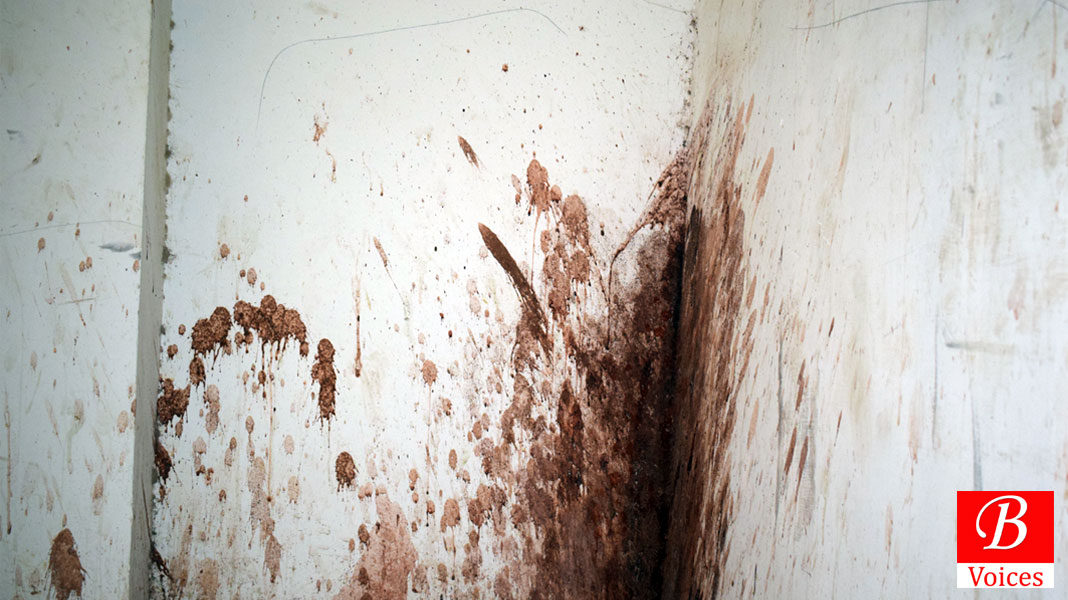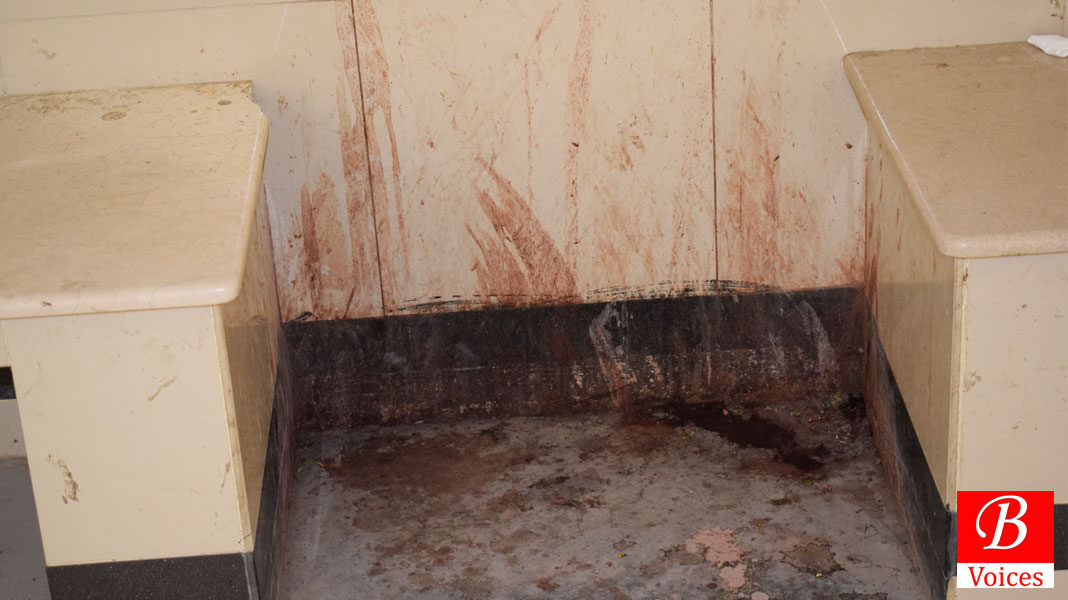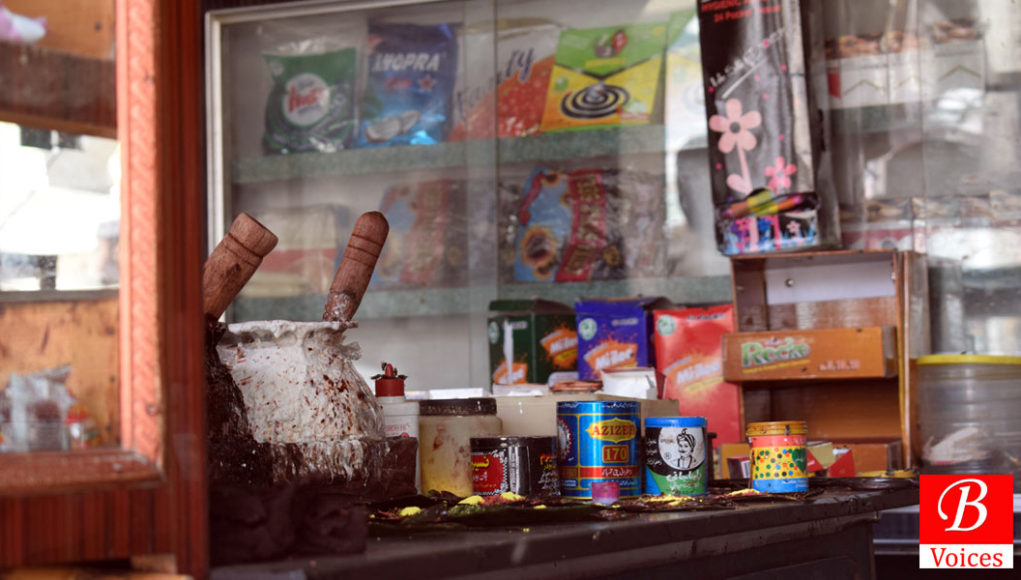Razia, 38, is a resident of Hub City—an industrial hub. She is the mother of four daughters and has been working as a maidservant at different schools and homes to earn a livelihood. She looks after the whole family including her aged mother and children. She is quite concerned about the career of her children and remains perturbed as her financial conditions is too constraint. She has been looking after her family alone since after the untimely death of her husband, who was a policeman.
“My husband died of mouth cancer 12 years ago. He used to have smokeless chewing tobacco. He was diagnosed with mouth cancer and got treatment for some time. Finally, he had a surgery. During surgery he died,” Ms Razia laments the death of her husband. “Brother of my husband also met with the same fate as did my husband. He [brother of her husband] used to have gutka and other smokeless chewing tobacco, and he also suffered from cancer,” she adds.
I earn a small amount monthly which is not enough to sustain educational expenses of my children particularly my daughters. I wish they were educated like other girls and stood on their own feet, she says showing her concern about the future of her children.
Gutka as a symbolic value addition to culture
During a quiet solace journey in a local bus towards Gaddani shore in order to have a slight slice of calm and relaxation, I felt surrounded by spiting voices—a normal routine practised by ‘gutka’ chewers in Pakistan. The calmness had put a layer of relaxation on my mind, yet my ears alerted with a crackle erupting from one of the seats behind. In fact, it was some laughter I heard when an old man in his 60s uttered few words in ‘praise’ of ‘Mawa’—a carcinogenic smokeless tobacco product.
“Mawa khanay ki cheez hai bhai [Mawa is more joyfully eaten than any other smokeless chewing tobacco],” the old man preferably said to his friend. The ‘betel quid’ or ‘smokeless chewing tobacco consumption, as asserted in a report titled “Risks of Betel Quid and Tobacco Use” published in July 2017 by Public Heath Law Centre, enjoy a societal acceptance in many societies.
Betel quid, generally referred as ‘paan’, a smokeless tobacco product, contains the term ‘gutka’ when used without ‘betel leaf’ with added ‘areca nut and slaked lime’. With enjoying a societal acceptance, ‘gutka’ chewing has become a symbolic value added to the demographic and cultural outlook of district Lasbela.

Preparation of Gutka and Mawa
The mixture of areca nut (chahliya), slaked lime (choona) and nicotine-enriched tobacco without betel leaf makes ‘gutka’. It poses a high health risk as its production contains most of other hazardous chemical ingredients. According to Public Health Law Centre, Gutka is consumed by around 600 million people mostly belonging to India, Bangladesh and Pakistan as well as Asia. ‘Mawa’, on the other hand, contains a particular powder known as ‘China Powder’ along with areca nut, slaked lime and nicotine-enriched tobacco.
“I make mawa without ‘China Powder’ as I know it is quite harmful for health and it can cause fatal diseases,” claims a mawa dealer showing some mawa from his own prepared product.
Gutka preparation is quite complex. It contains a lot of chemicals including a particular chemical which keeps it fresh for many days. With the usage of this chemical, gutka does not get stale, yet remains highly deleterious to health, he explains.
Gutka consumption and related health hazards
WHO’s sponsored group ‘International Agency for Research on Cancer (IARC) proves that habit of chewing smokeless chewing tobacco leads to cancer. The agency declares both ‘betel quid without added tobacco’, ‘betel quid with added tobacco’ or areca nut as carcinogenic to human.
Similarly, as per National Institute of Health’s Medline Plus, the long-term chewing of areca nut alone leads to oral submucosal fibrosis, a precancerous condition which halts jaw movement, which eventually becomes incurable in later stages.

“We have held seminars and spread awareness through newspapers. We have repeatedly been saying that areca nut (chahliya), gutka and Panprag are hazardous for health. Particularly areca nut is dangerous because it is arsenic (toxic) which causes cancer,” explains Prof. Dr. Kalimullah Thahim, a Karachi based ENT surgeon. “Startlingly, children have smokeless chewing tobacco products such as gutka, mawa and areca nut (chahliya). And, they often come to us with a ‘trimus complaint’ a term which refers to the malfunctioning of jaws. Firstly, we treat them with some injections. If they don’t get relief, we go for a thorough operation; but it is a precancerous condition which is not curable,” he adds.
Laws related to prohibition of smokeless tobacco products
Tobacco consumption and chewing smokeless tobacco products such as gutka, chahliya, mawa and mainpuri have intermittently been prohibited by laws promulgated throughout the country. Though the later has no any specific mention in laws, yet tobacco bans legitimately circle it. Being a signatory of WHO’s Framework Convention on Tobacco Control (FCTC), Pakistan has enacted significant laws on tobacco control, which has led to the establishment of Federal Tobacco Control Cell (FTCC).
The first law was enacted under the Vendors Act 1958 which brought all tobacco manufacturers, sellers or dealers under a certain obligation of acquiring an official license first. Later on, in 1969 government tried to regulate tobacco manufacturing through a Tobacco Board. Moreover, in 1979, it was decided to start certain warnings in written form on tobacco products. This led to the enactment of “The Cigarettes (Printing of Warnings) Ordinance” which aimed at creating awareness about increased health risks caused by tobacco consumption.

Similarly, in 2002, a significant law came to scene which defined the tobacco consumption in a broader view. “Prohibition of Smoking and Protection of Non-smokers Health Ordinance (2002)” contains clauses which prohibit tobacco or smokeless tobacco consumption at public places. With an extension in Ordinance, 40% of printed warnings were converted into pictorial warnings in 2010.
After the 18th amendment to the constitution, tobacco-related laws at provincial level remain either ineffective or at least seem nowhere in sight! Except Sindh and Punjab, other provinces score a little or zero on the graph to put an embargo on tobacco consumption.
Ironically, in Balochistan, the administrative framework has the only treatment to the malaise of gutka and mawa chewing is section 144.
“Section 144 is the only option we are left with to curb the situation, however, for a time being. After the imposed duration of ban finishes the business runs as usual,” shares an administrative official on the condition of anonymity. “Curbs are not a solution to the matter. Social awareness is the only panacea to get rid of this malaise,” he suggests.
District Lasbela, lying adjacent to Mega City Karachi, is the trailblazer in terms of gutka consumption, as the following widely used ‘maxim’ endorses the fact:
“When the people from other provinces reached Lasbela, they wondered after seeing the red blood stains [red coloured saliva produced during chewing ‘gutka’] on road sides. They thought Lasbela was engulfed by a ‘bloody war’ as the blood spilled over the roadside and everywhere they trolled”!
Currently, the entire province seems to have been engulfed by the same ‘bloody war’ [stains of gutka spit] absorbed as cultural symbol added to the cultural values.
Share your comments!








